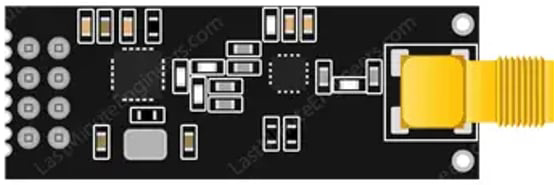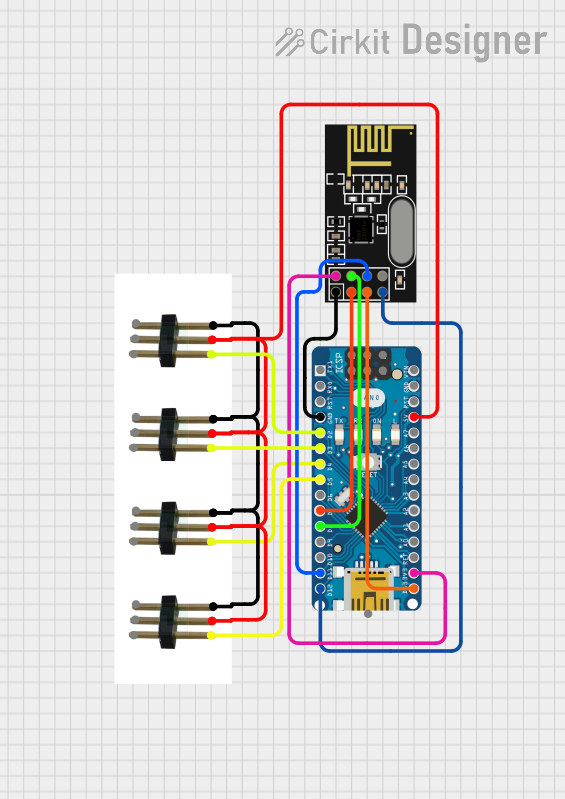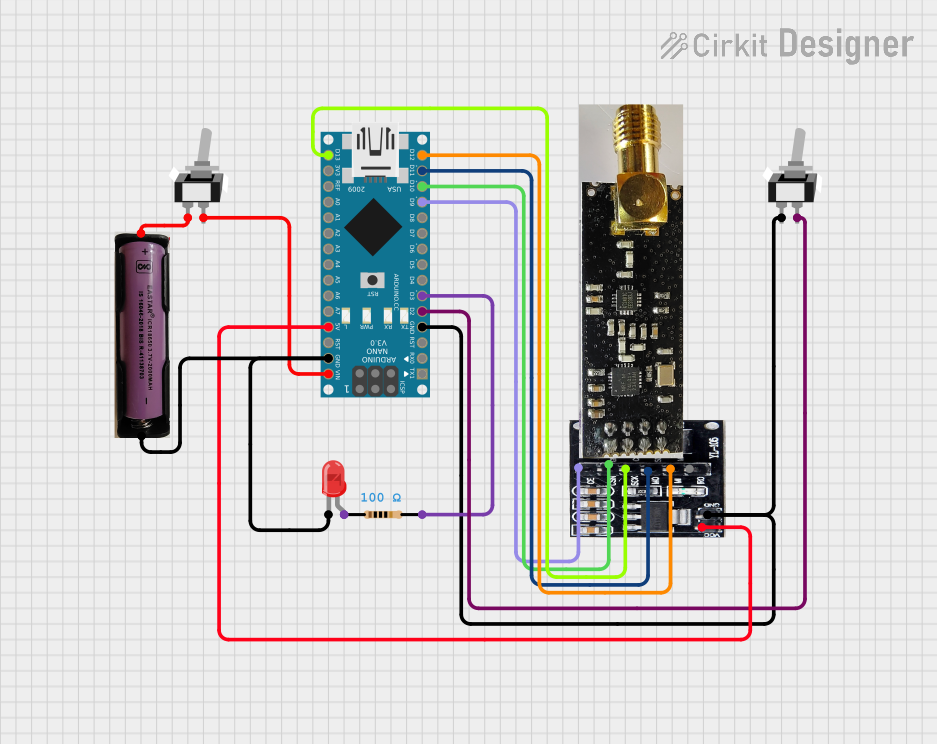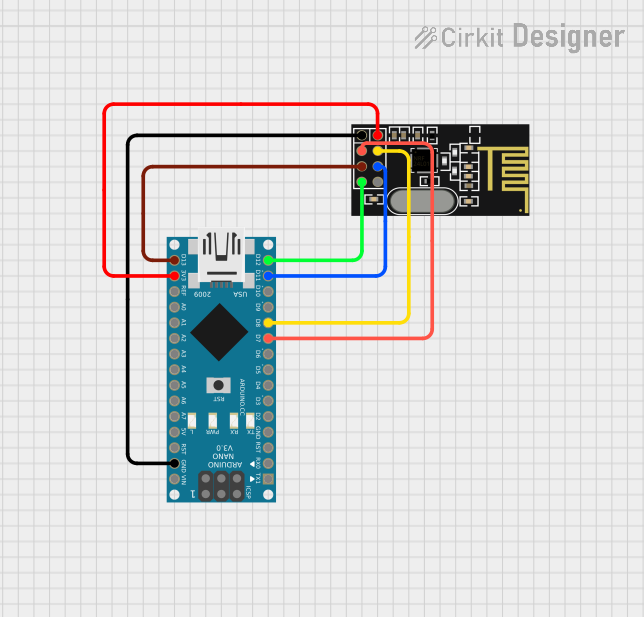
How to Use nrf24l01+pa+lna: Examples, Pinouts, and Specs

 Design with nrf24l01+pa+lna in Cirkit Designer
Design with nrf24l01+pa+lna in Cirkit DesignerIntroduction
The nRF24L01+PA+LNA, manufactured by Nordic Semiconductor ASA, is a low-power 2.4GHz transceiver module designed for wireless communication. It features a built-in power amplifier (PA) and low-noise amplifier (LNA), which significantly enhance its range and signal quality. With a maximum range of up to 1,000 meters (line of sight) and a high data rate of up to 2 Mbps, this module is ideal for applications requiring reliable and long-range wireless communication.
Explore Projects Built with nrf24l01+pa+lna

 Open Project in Cirkit Designer
Open Project in Cirkit Designer
 Open Project in Cirkit Designer
Open Project in Cirkit Designer
 Open Project in Cirkit Designer
Open Project in Cirkit Designer
 Open Project in Cirkit Designer
Open Project in Cirkit DesignerExplore Projects Built with nrf24l01+pa+lna

 Open Project in Cirkit Designer
Open Project in Cirkit Designer
 Open Project in Cirkit Designer
Open Project in Cirkit Designer
 Open Project in Cirkit Designer
Open Project in Cirkit Designer
 Open Project in Cirkit Designer
Open Project in Cirkit DesignerCommon Applications
- Remote controls for drones, cars, and other devices
- Wireless sensors and monitoring systems
- Internet of Things (IoT) devices
- Home automation systems
- Industrial wireless communication
Technical Specifications
The nRF24L01+PA+LNA module is based on the nRF24L01+ transceiver IC, with additional amplification circuitry for extended range and improved signal quality. Below are the key technical details:
| Parameter | Value |
|---|---|
| Operating Frequency | 2.4 GHz ISM band |
| Data Rate | 250 kbps, 1 Mbps, 2 Mbps |
| Operating Voltage | 1.9V to 3.6V |
| Recommended Supply Voltage | 3.3V |
| Current Consumption | 115 mA (transmit mode, max power) |
| Communication Interface | SPI |
| Output Power | Up to +20 dBm |
| Sensitivity | -94 dBm at 1 Mbps |
| Range | Up to 1,000 meters (line of sight) |
| Antenna Type | External SMA antenna |
Pin Configuration and Descriptions
The nRF24L01+PA+LNA module typically has an 8-pin interface. Below is the pinout and description:
| Pin | Name | Description |
|---|---|---|
| 1 | GND | Ground connection |
| 2 | VCC | Power supply (3.3V recommended) |
| 3 | CE | Chip Enable: Activates RX or TX mode |
| 4 | CSN | Chip Select Not: SPI enable (active low) |
| 5 | SCK | Serial Clock: SPI clock input |
| 6 | MOSI | Master Out Slave In: SPI data input |
| 7 | MISO | Master In Slave Out: SPI data output |
| 8 | IRQ | Interrupt Request: Indicates data received or transmit complete (optional use) |
Usage Instructions
How to Use the nRF24L01+PA+LNA in a Circuit
- Power Supply: Connect the VCC pin to a 3.3V power source. Do not connect it directly to 5V as it may damage the module. Use a 10 µF capacitor across VCC and GND to stabilize the power supply.
- SPI Interface: Connect the SPI pins (CSN, SCK, MOSI, MISO) to the corresponding SPI pins on your microcontroller.
- CE Pin: Use a GPIO pin on your microcontroller to control the CE pin. Set it high to enable RX/TX mode.
- IRQ Pin: Optionally connect the IRQ pin to a GPIO pin on your microcontroller to handle interrupts for data reception or transmission.
- Antenna: Attach the external SMA antenna to the module for optimal range and performance.
Important Considerations
- Power Supply: Ensure a stable 3.3V power supply. If using a 5V microcontroller, use a 3.3V regulator or level shifter for the SPI pins.
- Decoupling Capacitor: Place a 10 µF capacitor close to the module to reduce noise and improve stability.
- Antenna Placement: Position the antenna away from metal objects and other sources of interference for maximum range.
- SPI Speed: Configure the SPI clock speed to a maximum of 10 MHz for reliable communication.
Example Code for Arduino UNO
Below is an example of how to use the nRF24L01+PA+LNA module with an Arduino UNO. This code uses the popular RF24 library.
#include <SPI.h>
#include <nRF24L01.h>
#include <RF24.h>
// Define the CE and CSN pins for the nRF24L01+ module
#define CE_PIN 9
#define CSN_PIN 10
// Create an RF24 object
RF24 radio(CE_PIN, CSN_PIN);
// Define the address for communication
const byte address[6] = "00001";
void setup() {
Serial.begin(9600); // Initialize serial communication
radio.begin(); // Initialize the nRF24L01+ module
radio.openWritingPipe(address); // Set the address for transmission
radio.setPALevel(RF24_PA_HIGH); // Set power amplifier level
radio.stopListening(); // Set the module to transmit mode
}
void loop() {
const char text[] = "Hello, world!";
bool success = radio.write(&text, sizeof(text)); // Send data
if (success) {
Serial.println("Message sent successfully!");
} else {
Serial.println("Message failed to send.");
}
delay(1000); // Wait 1 second before sending the next message
}
Notes:
- Install the RF24 library in the Arduino IDE before running the code.
- Adjust the CE and CSN pin definitions if using different GPIO pins.
Troubleshooting and FAQs
Common Issues
Module Not Responding:
- Ensure the module is powered with a stable 3.3V supply.
- Verify the SPI connections and pin definitions in your code.
Short Range or Poor Signal:
- Check the antenna connection and placement.
- Ensure there are no obstructions or interference sources near the module.
Data Transmission Fails:
- Verify that the transmitter and receiver are using the same address and data rate.
- Check the CE and CSN pin configurations in your code.
High Current Draw:
- Ensure the power supply can provide sufficient current (at least 150 mA).
- Use a decoupling capacitor to stabilize the power supply.
Tips for Troubleshooting
- Use a multimeter to check the voltage at the VCC pin.
- Test the module with a simple example code to verify basic functionality.
- If using multiple modules, ensure each has a unique address to avoid conflicts.
By following this documentation, you can effectively integrate the nRF24L01+PA+LNA module into your wireless communication projects.